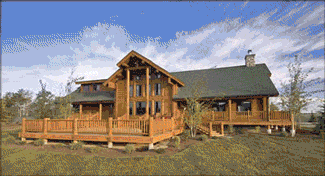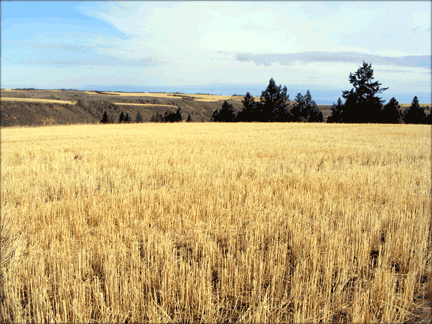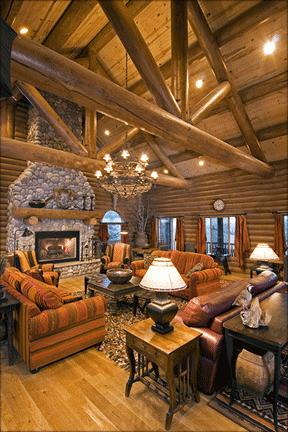Traditional English Driven Shoots Come to the Big Hole Mountains of Idaho

Here at an altitude of 6,000 feet, the aromas of pine trees, sage brush and spent Holland & Holland shells mingle together in the Big Hole Mountains of Idaho where Lars Magnusson has introduced traditional English driven shoots on American soil.
We are at the luxurious Lazy Triple Creek Ranch. Lars’ organization, Blixt & Co., holds the exclusive hunting and fishing rights to 2,200 acres on the ranch. With many members of our shooting party wearing breeks and tweed, the eight of us likeminded shooting enthusiasts are here to experience the inaugural traditional driven shoot of the Blixt & Co. Syndicate.
Make no mistake about it, Lars is on a mission to up-end the American conceit of so-called driven shoots with his own highly orchestrated extravaganzas. Forget the tower shoots where pen-raised birds fly for the first time in their lives after being hand-tossed from a 50-foot high platform, or even shoots where just-released birds-in-a-box are driven towards a line of guns. Lars will make a convincing case as to why they are not traditional driven shoots.

Under the banner of Blixt & Co., Lars is dedicated to faithfully replicating the driven shoots that you would find in Devon, Yorkshire, Wiltshire and Somerset. As carried out by Lars, an army of beaters marches through fields of wheat, corn and sunflowers to flush near-wild pheasants here in the reaches of Idaho for a limited number of eight guns per Syndicate shoot.
The magnitude of Lars’ enterprise would easily slip by most American shooters who have never drawn a peg on an English estate. There are only three places in North America that hold true English-style driven shoots – all of them invitation-only affairs. Two take place on private property in Canada while the third is restricted to an exclusive island north of Manhattan.
But Lars has thrown open the doors to American wingshooters with a penchant for Anglophile lifestyles. Although the Blixt & Co. Shooting Syndicate (and their Ladies Syndicate) entitles you to take part in various events at different shooting estates in the U.S, it is at the Lazy Triple Creek Ranch in Newdale, Idaho where Lars has laid the groundwork for his traditional English driven shoots.
Now, with two preliminary shooting seasons serving as rehearsals, the eight of us are ready to see what Lars really has to offer in the first Syndicate shoot conducted by Blixt & Co.
Who are these American sportsmen who signed up for Lars’ inaugural shoot?
There’s Scott, a hedge-fund manager in the Midwest; Greg, an independently wealthy media entrepreneur from the West Coast; Ed, a local advertising luminary now on his second career; and Ben, a retired telecommunications executive from the South. On the day of the actual driven shoot we are joined by one of the ranch’s partners. (Some of the men were accompanied by their wives who didn’t shoot but certainly savored the surroundings.) I drove to the Lazy Triple Creek Ranch from the Denver area, where I met up with Michael Sabbeth, a frequent contributor to Shotgun Life and other top shooting magazines.
In order to grasp what Lars has accomplished it’s important to appreciate what goes on behind the scenes. The Blixt & Co. commitment to traditional English driven shoots is the culmination of decades of experience.
Lars’ father and grandfather plied the famed Scandinavian hunting grounds where he was raised. His formal education in the shooting sport started in 1993 at Sweden’s first shooting school. Two years later he was recruited by the West London Shooting School, one of the world’s oldest and most prestigious.
Following his time with the West London Shooting School, Lars helped establish the West Stockholm Shooting School in Sweden. In 2003 Lars was approached by Griffin & Howe, one of the premier gun companies in the U.S. He became Managing Director of their shooting school at Hudson Farm in Andover, New Jersey. He held that position until 2006 when he went to assist in the establishment of a private shooting estate at Lazy Triple Creek Ranch. Blixt & Co. was formed with Lars’ desire to help new and existing land owners build and manage their own shooting estates. Lazy Triple Creek is a perfect example of where Lars has realized his vision of a traditional driven shoot on American soil.
Lars’ right-hand man is gamekeeper, Matt Whindle of England. Matt grew up learning the time-honored traditions and practices of the classic English country shooting estate. He has spent more than 20 years running some the most prominent shoots outside the U.S.
Being an expert in bird management; rearing, releasing and the execution of driving the birds on the shoot day, Matt was invited in 1997 to create an English-style driven pheasant shoot on the prestigious Vysoky Chlumec Estate near Prague, in the Czech Republic. This experience led Matt to positions as a consultant to exclusive shoots in Tuscany, Bavaria, New Zealand and now the US.

Lars’ wife, Jennifer, is a native of nearby Jackson Hole, Wyoming. As owner of a successful ad agency and graphic design firm, she is the Marketing Director of Blixt & Co. but also gets into the hospitality logistics to ensure the satisfaction of the guests.
The crew of the Lazy Triple Creek ranch pitches in on a daily basis, and, as we were to discover, an eclectic group of locals dedicated to Lars’ success will rally to his side on shoot day. About 50 people – including beaters, loaders, dog handlers, game cart drivers and lodge staff – pitched in to create a spectacular experience for the eight guns and their companions.
The driven shoots actually begin months before a blast from the hunting horn signals that the march of the beaters is ready to commence.
Three-hundred acres of sage brush are plowed under to make way for the wheat, corn and sunflower fields planted on three adjacent ridges. The fields serve as a natural habitat for the birds. From the sprawling rear deck of the lodge, the high-altitude fields are a patchwork of gold, brown and green bejeweled by the pristine air and brilliant sun.
After the birds are delivered to the Lazy Triple Creek Ranch, Matt takes over their management. Several large pens near the crop fields hold hundreds of birds. The pens are equipped with a nipple-based water system. Sunflower heads and corn are grown inside the pens in order to create cover. The goal is to acclimatize the birds to their food source before releasing them.
Three to four days later, the birds are gradually allowed into the fields. This method mimics the way partridges are raised for driven shoots in the U.K. By the time the birds under Matt’s supervision reach 20 to 24 weeks, they have been exposed to predators and natural feeding – making the survivors plump, strong-flying birds. They also developed a homing instinct vital to the birds being successfully flushed by the beaters.
As Matt explains it, “You have to get the birds as wild as possible so that they run and fly as fast as possible. Because they are on the ground longer, they behave more a like a wild bird than one that just came out of the box.”
Tuesday, October 13th, was our first day of shooting, but it was with clay pigeons. Lars wanted us to practice for the actual shoot on the 14th.
Before heading out, we enjoyed one of the superb meals prepared by local chef, Mark Slawson – a student of the California Culinary Academy in San Francisco and veteran of Jackson Hole’s many fine restaurants.
Fortified with heaping servings of elk chili, salad and fresh bread, we drove down the switchback trails to the five-stand course where Lars pulled targets in a continuous flurry. We then moved to the grouse butt where true pairs of fairly high incomers would familiarize us with the pheasants. Afterwards, we took positions at the simulated pheasant flurry. We practiced a drill where one of us acted as a loader, while the other shot at the high-flying clay birds, so that each gun got a sense of the driven shoot.
Naturally, we were making fast friends with our fellow guns – relationships that would warm quite nicely over cocktails, dinner and cigars.

With evening drawing in, the vaulted timber interior of the lodge took on a golden hue in the lamp light and fire crackling in the hearth. For cocktails, we congregated in the great room – the furnishings evocative of Ralph Lauren’s Santa Fe.
Moving into the intimate dining room, we enjoyed herb-roasted pork loin, sweet-potato gratin, sautéed char, a salad and creamy tiramisu for dessert. Wine was poured in abundance.
While most of us returned to the great room, I ambled out to the front porch for a cigar where I met Greg who was already enjoying one from his own collection. An easy conversation ensued until we decided to pack it in for the big day that started at 8:00 the next morning.
We girded ourselves with a satisfying breakfast of vegetable quiche, fresh fruits, bread and various breakfast meats in anticipation of the six scheduled driven shoots of the day.
We assembled on the back verandah to draw pegs and meet our loaders. I was matched up with a guy who had graduated from an Ivy League college. A wine connoisseur and local photography legend, he proved to be an able companion who stressed safety and was good for lively conversation during the occasional lull.
Low clouds and a mountain mist foreshadowed rain. While some of the shooters chalked it up to authentic British weather, the fronts that moved through the Lazy Triple Creek Ranch far surpassed the gloomy soaks of the U.K.
At this altitude and proximity to mountain ranges and the Teton Pass, the weather was a tempestuous diva. A succession of roiling clouds would arrive with their showers, only to quickly move on and bare a bluebird sky. The vibrant climate energized the day – and never dampened our spirits.
Once the eight guns and their loaders arrived at their pegs on the valley floor, Lars blew the hunter’s horn. All eyes rose to the tree tops. Beyond the crest, Matt had organized lines of beaters. Whipping orange flags, banging sticks, shouting and making a general commotion they slowly advanced through the fields under Matt’s strict command.
You could track the beaters’ movement by the direction that the pheasants flushed over the crest of the hill. The birds would come into view individually, pairs, or suddenly a covey would burst over the tree tops at 30-50 mph as volleys firing down the line struck the birds that collapsed and fell.
At about 11:00 am, we broke for elevenses – the traditional Commonwealth morning refreshment of hot beverages and snacks. The covered wagon brought us down to an old, rough-hewn woodshed for chicken consommé, coffee, biscuits and cheese. The rain had been falling for a while now, the guns and loaders huddled up with their steaming cups.
All told, we rotated through four driven shoots before lunch and everyone was famished.
Returning to the lodge we were rewarded with a rib-sticking lunch of elk shepherd’s pie, salad and “kitchen sink” cookies for dessert. Soon, we were back in the wagon for our ride back to the pegs in another lovely valley.
It was now our fifth driven shoot and the weather had cleared considerably. In the aftermath of the rain, winds propelled the birds to loftier heights and higher speeds. If the birds didn’t come across your peg, you could still hear shots elsewhere as Matt’s beaters combed the fields above the valley floor.
We were assigned different pegs for the sixth drive and this time fewer trees provided an unobstructed view of the ridge. As the birds seemed to catapult into view it was easier to get them early as you followed the line of belly, beak, bang.
The final horn of the day sounded at about 5:00 pm. The guns and loaders gathered together to share tales of the hunt in anticipation of the game parade. For American shooters unfamiliar with this European tradition, the game parade honors the game that had been shot on that day, and provides the opportunity for the guns to thank all the beaters, loader and dog handlers for their hard work.
We would find out later that our tally came to 181 pheasants and 10 partridge. With 929 shots fired, that gave us a shot ratio of five to one. And yes, there were still plenty of birds out there for the next day, when we would get another chance at them with our walk-up shoot. In the mean time, it was back to the lodge for cocktails and dinner.
It was too soon for Mark to dress the birds and so the dinner that arrived before us was a filet with fingerling potatoes and lake green beans, salad and a splendid dessert of vanilla ice cream sandwiched between blueberry and strawberry sorbet. With wine and a fire and the candle light the fellowship ran high as we knew it would be our last evening together at this wonderful table.
Once again, Greg and I found ourselves on the wide front porch smoking after-dinner cigars when Ed called us out to look at the Milky Way that stretched across the night. We went to the rear of the lodge and marveled at the universe in the autumn chill, until the
warm light from the great room became irresistible.

I woke up early Thursday and started to pack. It would be time to leave the ranch after the half-day, walk-up shoot. We polished off another hearty breakfast of eggs, bacon and a hash of potatoes with elk and pork sausage. We then paired into parties of two. Mike and I were teamed up with guide and dog handler, Glen Cropper of Spring Slough Kennel in Idaho Falls.
Glen drove a six-wheel ATV with built-in custom kennels for four dogs. A bench seat was mounted high atop the kennels. Mike and I climbed the ladder up to the seat, giving us a stagecoach view of the property as Glen navigated down the switchbacks – the dogs directly under us making yearning sounds.
The morning cloud cover had broken by the time we arrived in a meadow of sage brush. The vistas were magnificent as the ridges rolled into the meadows under an expansive sky turning clear and radiant.
Over the next four hours, Mike and I would take seven pheasants, roosters and hens, flushed by Glen’s dogs. I shot the first two birds of the morning with my old Beretta Silverhawk, while Mike made a clean sweep, taking more than one impressive quartering away shot with that beautiful old Boswell of his.
For lunch, we were treated to a delicious pheasant gumbo stocked with meat from our quarry. While Scott rushed out to make an early flight in Jackson Hole, the rest of us lingered at the familiar table, reluctant to leave.
Irwin Greenstein is Publisher of Shotgun Life. You can reach him at letters@shotgunlife.com.
Useful resources:
Blixt & Co.

Irwin Greenstein is Publisher of Shotgun Life. Please send your comments to letters@shotgunlife.com.


Comments